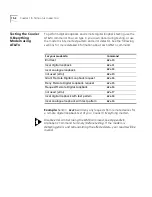
15-8
C
HAPTER
15: T
ESTING
THE
CONNECTION
Testing Using
Built-in Test Pattern
(AT&T7)
This test option causes the modem to perform a remote digital loopback
test by sending a built-in test pattern. An internal error detector counts
any errors and, when the test is ended, sends the number of errors or 00
(no errors) to the screen.
Follow the steps below. However, you don't need to type anything during
this test. The modem sends only its final error count to your screen
1
Send
AT&M0&N3S14.0=0
to prepare the Courier V.Everything modem for
testing.
This command disables error control, fixes the connection rate at 2400
bps, and makes the Courier V.Everything modem return to command
mode when you type the escape code (
+++
).
2
Establish a connection with the remote device
3
If you haven't already done so, arrange with the remote user t
cooperate with the test.
If necessary, set the remote device to acknowledge the remote digital
loopback request. For example, older 3Com modems need to be set to
S16=8.
4
Send
AT&T7
to the modem. The modem enters remote digital loopback
mode, and, if the modem is an external model, the MR status light
flashes.
The Courier V.Everything modem sends its built-in test pattern to the
remote device, which loops it back to your Courier V.Everything modem.
You will not see the data on your screen.
5
Send the escape code,
+++
, and then
AT&T0
to end the test. You can also
end the test by sending
ATH
,
ATZ
, or
ATZ!
Be careful, though, because
ATZ and ATZ! reset the Courier V.Everything modem in addition to ending
the test.
If you issue an invalid command, the Courier V.Everything modem sends
an ERROR message. If you set Register S18, the Courier V.Everything
modem automatically ends the test when the test timeout is reached. See
the example in the previous section,
Stopping a Test
for an example of
using S18.
When the test ends, the Courier V.Everything modem returns a
three-digit code, followed by OK. A code of 000 indicates no errors were
found; a code of 255 indicates 255 or more errors.
Summary of Contents for Courier
Page 12: ......
Page 28: ...1 14 CHAPTER 1 CONNECTING TO YOUR ISP ...
Page 36: ...3 4 CHAPTER 3 UPGRADING YOUR MODEM ...
Page 58: ...6 6 CHAPTER 6 WORKING WITH MEMORY ...
Page 64: ...8 4 CHAPTER 8 CONTROLLING EIA 232 SIGNALING ...
Page 72: ...9 8 CHAPTER 9 ACCESSING AND CONFIGURING THE COURIER V EVERYTHING MODEM REMOTELY ...
Page 80: ...10 8 CHAPTER 10 CONTROLLING DATA RATES ...
Page 96: ...12 6 CHAPTER 12 FLOW CONTROL ...
Page 108: ...13 12 CHAPTER 13 HANDSHAKING ERROR CONTROL DATA COMPRESSION AND THROUGHPUT ...
Page 112: ...14 4 CHAPTER 14 DISPLAYING QUERYING AND HELP SCREENS ...
Page 122: ...15 10 CHAPTER 15 TESTING THE CONNECTION ...
Page 142: ...17 8 CHAPTER 17 TROUBLESHOOTING ...
Page 156: ...A 14 APPENDIX A S REGISTERS ...
Page 172: ...B 16 APPENDIX B ALPHABETIC COMMAND SUMMARY ...
Page 178: ...C 6 APPENDIX C FLOW CONTROL TEMPLATE ...
Page 186: ...E 4 APPENDIX E V 25 BIS REFERENCE ...






























